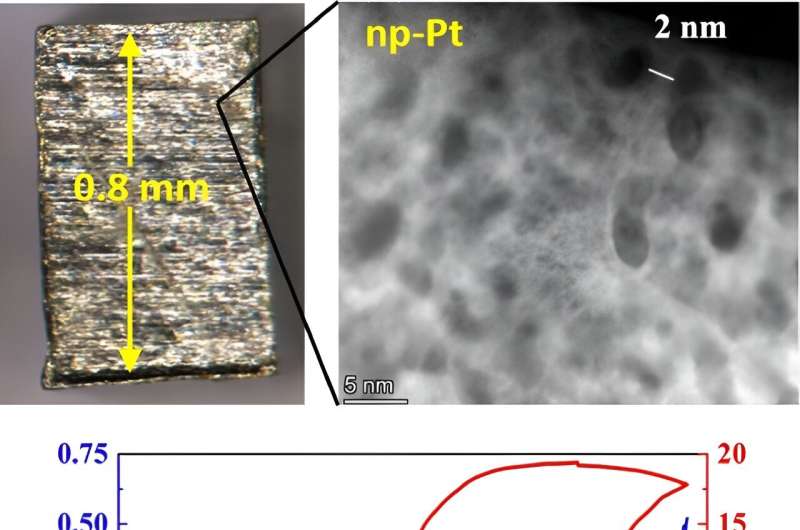This article has been reviewed according to Science X's editorial process and policies. Editors have highlighted the following attributes while ensuring the content's credibility:
fact-checked
proofread
Porous platinum matrix shows promise as a new actuator material

Actuators are common machine components that convert energy into movement, like the muscles in the human body, vibrators in mobile phones or electric motors. Ideal actuator materials need good electrochemical properties to repeatedly conduct electrical currents made of flowing electrons.
In addition, actuator materials require excellent mechanical properties to withstand the physical stress associated with continual movement. Nanoporous platinum (np-Pt), a platinum matrix containing tiny pores to increase energy conduction, was recently created in large quantities and in a cost-efficient manner, making np-Pt an ideal and more practical actuator material.
A group of material scientists from Hamburg University of Technology in Hamburg, Germany manufactured an ultrafine-ligament np-Pt material made up of a random, interconnected network of very fine platinum strands, or ligaments, as small as two nanometers (10-9 m) in diameter.
This network also creates tiny pores between the strands, which improves the movement of electrons or charged atoms through the material. Importantly, the team used an efficient manufacturing method that decreased the cost associated with synthesizing a np-Pt. By decreasing the diameter of the Pt strands, both the surface-to-volume ratio and the mechanical stability of the np-Pt material go up, improving the material's actuator performance.
The researchers published their study in Energy Materials and Devices.
Compared to other nanoporous metals and materials being investigated for their potential use as actuators, the team discovered that np-Pt was physically more robust and would likely work well as a sensor or detector material versus other nanoporous materials that are too fragile.
"The fine ligament size of np-Pt could provide an enhanced surface area which makes the material a promising… catalyst of chemical reactions as well as an actuator material," said Haonan Sun, first author of the paper and researcher in the Research Group of Integrated Metallic Nanomaterials Systems at Hamburg University of Technology. As a catalyst, np-Pt would speed the rate of specific chemical reactions.
What was most unique about the study was how the researchers manufactured the np-Pt material. "The main breakthrough in this research is that we obtained bulk np-Pt by electrochemical dealloying. Past studies on np-Pt were all based on nanoparticles or films that were prepared using more expensive commercial Pt particles. So the easy and cheap method of dealloying increases the practicality of np-Pt and makes further research possible," said Sun.
Specifically, dealloying is a process of selective leaching or corrosion where one component of an alloy, or material blend, is selectively removed from the material. Before the dealloying process, the material is a uniform blend. After the selective leaching process, the more chemically active blended materials are partially removed from the material, leaving tiny pores behind.
In this case, np-Pt was manufactured by selectively leaching copper from a platinum-copper alloy (Pt15Cu85) using sulfuric acid (H2SO4).
Prior to this study, np-Pt had also never been manufactured in larger bulk quantities. The research team suggests that the successful performance of bulk np-Pt serves as a model for the development of other nanoporous metals that may be investigated for their suitability as potential actuator materials, strain sensors or chemical reaction catalysts.
With the actuator material performance of np-Pt established, the team looks forward to determining the effects of the material on chemical reactions. "The next step of this study is to investigate the chemical catalyst property of our np-Pt. We have already found some very interesting phenomena with bulk np-Pt on the oxygen reduction reaction which combines oxygen and hydrogen to form water… and we would like to do some deeper research on that," said Sun.
More information: Haonan Sun et al, Bulk nanoporous platinum for electrochemical actuation, Energy Materials and Devices (2023). DOI: 10.26599/EMD.2023.9370006
Provided by Tsinghua University Press





















